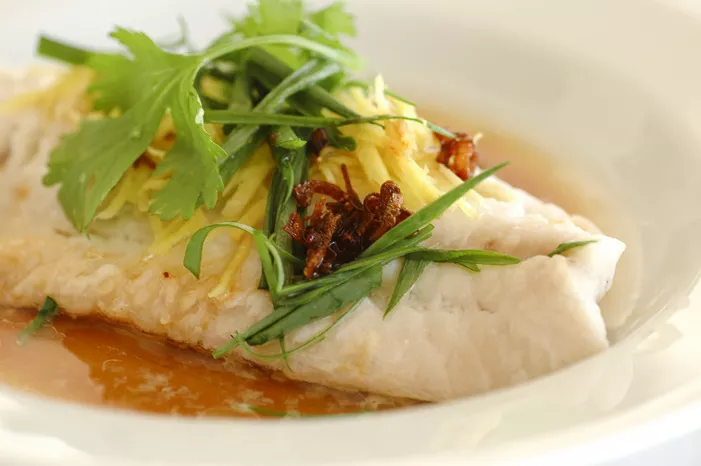Steamed fish Chinese style is a time-honored culinary treasure, celebrated for its simplicity, delicate flavors, and the health benefits it offers. This ancient cooking technique has been refined over centuries and remains a beloved dish in Chinese cuisine. Steamed fish exemplifies the essence of Chinese culinary traditions, where the focus is on enhancing the natural flavors of fresh ingredients. In this comprehensive guide, we will take you through the steps to create a perfect Chinese-style steamed fish, exploring the key ingredients, techniques, and regional variations.
The Essence of Chinese-Style Steamed Fish
Chinese-style steamed fish is an embodiment of balance and harmony. The dish exemplifies the principles of Yin and Yang, where the contrasting elements of ginger, scallions, soy sauce, and sesame oil come together to create a perfectly harmonious flavor profile. The gentle, moist cooking method preserves the natural sweetness and texture of the fish while infusing it with the fragrance of aromatic seasonings.
Choosing the Right Fish
The choice of fish is a critical factor in preparing Chinese-style steamed fish. While different types of fish can be used, a whole fish with firm, white flesh is ideal. Common choices include:
Sea Bass: Known for its mild flavor and flaky texture, sea bass is a popular option for steamed fish.
Red Snapper: With its firm and slightly sweet flesh, red snapper is a favorite choice in many Chinese households.
Tilapia: Tilapia is a more affordable option with mild-flavored flesh that works well for steaming.
Striped Bass: Striped bass offers a slightly stronger flavor and is often used in regional variations.
Flounder: Flounder is prized for its delicate, sweet flavor and thin fillets.
Black Cod: Renowned for its buttery texture, black cod is a luxurious choice for steaming.
Ingredients for Chinese-Style Steamed Fish
To create the perfect Chinese-style steamed fish, gather the following key ingredients:
Whole Fish: The centerpiece of the dish, as discussed earlier. The fish should be scaled and gutted, with the head and tail intact for presentation.
Ginger: Fresh ginger is essential for adding a zesty, aromatic element to the dish. Slice it into thin strips or julienne.
Scallions: Green onions provide a fresh, mildly oniony flavor. Cut them into long, thin strips.
Soy Sauce: High-quality soy sauce is used to season the fish, providing saltiness and depth of flavor.
Sesame Oil: Toasted sesame oil contributes a rich nuttiness and enhances the overall aroma.
Shaoxing Wine (optional): Shaoxing wine is a popular Chinese cooking wine that adds depth to the dish. If unavailable, you can substitute it with dry sherry.
Cilantro and Red Chili (optional): For garnishing and adding a touch of color and heat.
Step-by-Step Instructions for Chinese-Style Steamed Fish
Here’s a step-by-step guide to creating a perfect Chinese-style steamed fish:
Step 1: Start by choosing your fish. Ensure it’s scaled, gutted, and cleaned properly. Rinse the fish under cold water and pat it dry with paper towels. If your fish is too large for your steaming vessel, you can ask your fishmonger to cut it into sections.
Step 2: Score the fish by making three diagonal cuts on each side. This helps the fish cook evenly and allows the flavors to penetrate.
Step 3: Place the fish on a heatproof dish that can fit inside your steamer. A heatproof plate or shallow dish works well. Make sure to choose one with raised edges to collect the flavorful juices.
Step 4: Stuff the fish cavity with ginger strips and some of the sliced scallions. Use the rest of the ginger and scallions to sprinkle over the fish.
Step 5: Prepare a steamer large enough to accommodate the fish. If you don’t have a dedicated steamer, you can use a wok with a steaming rack or any other steaming equipment you have. Bring water in the steamer to a boil.
Step 6: Place the dish with the fish in the steamer, ensuring it’s not in direct contact with the boiling water. Cover the steamer and steam the fish for about 12-15 minutes, depending on the size of the fish. The fish is done when the flesh turns opaque and flakes easily with a fork.
Step 7: While the fish is steaming, you can prepare the sauce. In a small saucepan, heat soy sauce and Shaoxing wine over low heat. Once warm, remove it from the heat, and stir in the sesame oil.
Step 8: Carefully remove the steamed fish from the steamer, as it’s quite delicate. Pour the sauce evenly over the fish.
Step 9: Garnish the dish with cilantro and, if desired, a few slices of red chili for color and heat.
Step 10: Serve the Chinese-style steamed fish immediately, along with steamed rice, to enjoy the delicate flavors.
Tips for Perfect Chinese-Style Steamed Fish
Creating a perfectly steamed fish requires attention to detail. Here are some tips to help you achieve perfection:
A. Freshness is Key: Use the freshest fish available. The quality of the fish is the foundation of a successful dish.
B. Scoring the Fish: Scoring the fish allows it to cook more evenly and allows the flavors to penetrate the flesh.
C. Gentle Steaming: Steam the fish over gently simmering water. Rapid boiling can cause the fish to overcook or fall apart.
D. Steaming Time: The steaming time depends on the size and thickness of the fish. A good rule of thumb is to steam for about 8-10 minutes per inch of thickness.
E. Avoid Overcooking: Be careful not to over-steam the fish. Overcooked fish becomes dry and loses its delicate texture.
F. Use High-Quality Ingredients: The simplicity of this dish highlights the importance of using the best quality soy sauce, sesame oil, and Shaoxing wine you can find.
Health Benefits of Steamed Fish
Chinese-style steamed fish is not only a culinary delight but also a nutritious choice. Some of the health benefits of steamed fish include:
A. Low in Calories: Steamed fish is a low-calorie option, making it suitable for those watching their weight.
B. High-Quality Protein: Fish is an excellent source of high-quality protein, essential for muscle growth and repair.
C. Omega-3 Fatty Acids: Fish is rich in omega-3 fatty acids, which are known for their heart-healthy benefits.
D. Low in Saturated Fat: Unlike deep-fried or heavily sauced dishes, steamed fish is low in saturated fat.
E. Nutrient-Rich: Fish is a good source of essential nutrients, including vitamins D and B12, iodine, and selenium.
Conclusion
Chinese-style steamed fish is a culinary masterpiece that reflects the rich history and traditions of Chinese cuisine. This elegant and flavorful dish exemplifies the delicate balance and harmony that is at the heart of Chinese cooking. By choosing the right fish, mastering the techniques, and experimenting with regional variations, you can create a perfect Chinese-style steamed fish that delights the senses and nourishes the body.
























